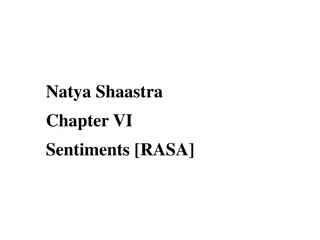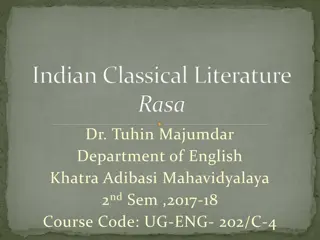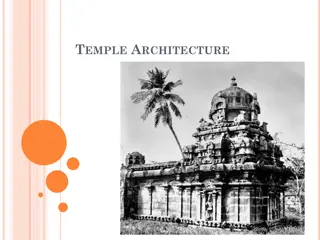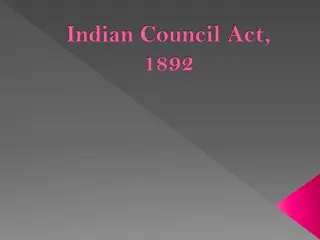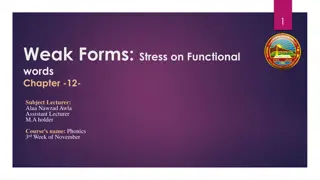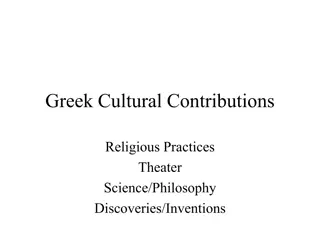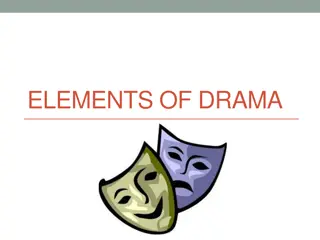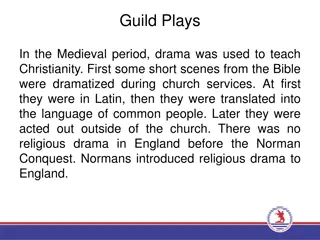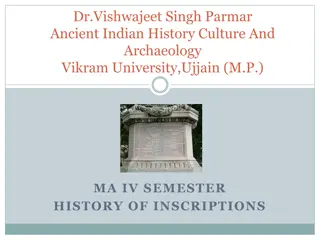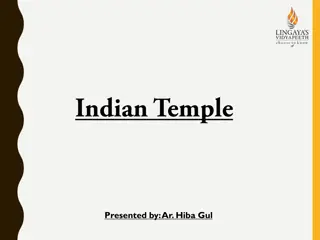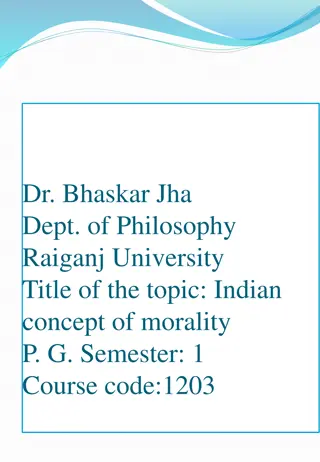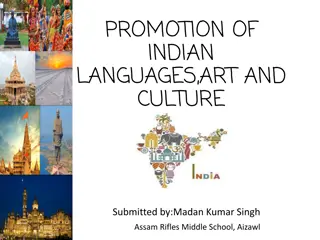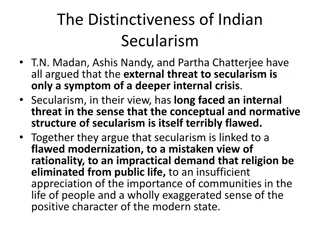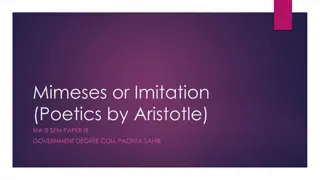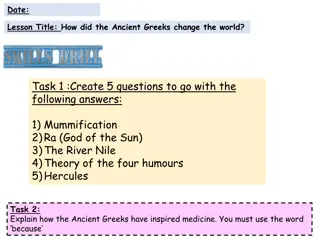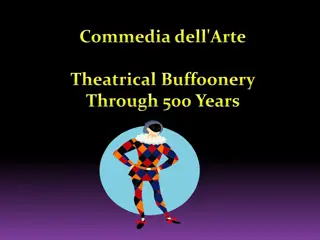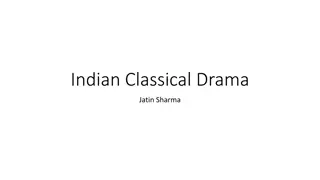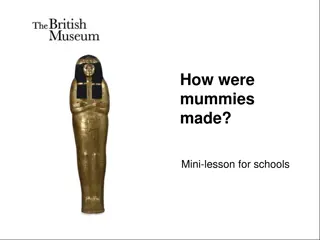Ancient Indian Theatrical Art Forms and the Theory of Rasa in Natya Shastra
The Natya Shastra, attributed to Bharata Muni, is an ancient treatise influencing Indian dance, music, and literary traditions. This comprehensive work covers various aspects of theatre, including acting, dance, music, and more. The concept of Rasa, denoting the aesthetic essence that evokes emotions in the audience, plays a central role in Indian aesthetics. The Rasa theory aims to transport the audience into a parallel world to ponder spiritual and moral questions.
Download Presentation

Please find below an Image/Link to download the presentation.
The content on the website is provided AS IS for your information and personal use only. It may not be sold, licensed, or shared on other websites without obtaining consent from the author. Download presentation by click this link. If you encounter any issues during the download, it is possible that the publisher has removed the file from their server.
E N D
Presentation Transcript
Natya Shaastra Chapter VI Sentiments [RASA]
Theory Natya Shaastra Bharata is considered the father of Indian theatrical art forms dated between 200 BCE and 200 CE. The N ya stra: an ancient encyclopedic treatise on the arts, which has influenced dance, music and literary traditions in India. Major source of evidence for Sanskrit theatre is A Treatise on Theatre (N tya stra), (estimates range from 200 BCE to 200 CE) and whose authorship is attributed to Bharata Muni. The Treatise is the most complete work of dramaturgy in the ancient world. It addresses acting, dance, music, dramatic construction, architecture, costuming, make-up, props, the organisation of companies, the audience, competitions, and offers a mythological account of the origin of theatre. Sanskrit theatre was performed on sacred ground by priests who had been trained in the necessary skills (dance, music, and recitation) in a hereditary process. Its aim was both to educate and to entertain. Bh sa (born 3rd century AD, India), the earliest known Sanskrit dramatist.
Under the patronage of royal courts, performers belonged to professional companies that were directed by a stage manager (sutradhara), a puppeteer the literal meaning of "sutradhara" is "holder of the strings or threads". There were no prohibitions against female performers; companies were all-male, all- female, and of mixed gender. Certain sentiments were considered inappropriate for men to enact, and were thought better suited to women. Of all the elements of theatre, the Treatise gives most attention to acting (abhinaya), which consists of two styles: realistic (lokadharmi) and conventional (natyadharmi), though the major focus is on the latter. Information: However, its most complete exposition in drama, songs and other performance arts is found in the works of the Kashmiri Shaivite philosopher Abhinavagupta (c. 1000 CE), demonstrating the persistence of a long-standing aesthetic tradition of ancient India. The Abhinavabh rat is the most studied commentary on Natyasastra, written by Abhinavagupta (950 1020 CE), who referred to Natyasastra also as the Natyaveda.
Chapter VI of Natyashaastra Sentiments[Bhava Rasa] In Indian aesthetics, rasa (Sanskrit: ) literally means "juice, essence or taste". It connotes a concept in Indian arts about the aesthetic flavour of any visual, literary or musical work that evokes an emotion or feeling in the reader or audience but cannot be described. Rasas are created by bhavas ( the state of mind.) It refers to the emotional flavors/essence poured into the work by the writer and relished by a 'sensitive spectator' or sah daya,literally one who "has heart", and can connect to the work with emotion, without dryness.
According to the Rasa theory of the Natya Shastra, the primary goal, apart from providing sheer entertainment, is to transport the audience into another parallel world, full of wonder and bliss, where they experience the essence of their own consciousness, and reflect on spiritual and moral questions.
The word rasa appears in ancient Vedic literature. Rasa in an aesthetic sense is suggested in the Vedic literature. In Rigveda {The Knowledge of Verses}[Rig = hymns for praying to the Vedic Gods such asAgni (Fire God), Indra (The lord of Heavens), Mitra, Varuna (Water God), Surya (Sun God) etc] it connotes/ implies a liquid, an extract and flavor. In Atharvaveda [The Atharva Veda is a Vedic-era collection of spells, prayers, charms, and hymns. There are prayers to protect crops from lightning and drought, charms against venomous serpents, love spells, healing spells, hundreds of verses, some derived from the Rig Veda, all very ancient], rasa in many contexts means "taste", and also the sense of "the sap of grain". In the Upanishads according to Daniel Meyer-Dinkgr fe a professor of Drama, rasa refers to the "essence, self-luminous consciousness, quintessence [purest essence/ether]" but also "taste" in some contexts. In post-Vedic literature, the word generally connotes "extract, essence, juice or tasty liquid".
The rasa theory in Chapter 6 of Natya Shaastra begins its discussion with a sutra called in Indian aesthetics as the rasa sutra: Rasa is produced from a combination of the following states: Determinants [ Cause/ Reason/ Kaaran) Consequents [Anubhava] Transitory [Vyavicharibhava]
Determinants (vibhava) [cause/ karana] Vibhava is of two types: Alambana Vibhava and Uddipana Vibhava. Alambana Vibhava refers to the main stimulating cause. Eg. The emotional experience Sita felt at the sight of Shri Rama is an example of Alambana Vibhava. Uddipana Vibhava refers to excitants that support the main stimulating factors in evoking an emotion] Eg. When Sita was left alone after seeing Rama, the feeling she had can be compared to Uddipana Vibhava.
Consequents (anubhava) means the ensuants or effects following the rise of the emotion. Eg. Narrative or ritual experience, enjoyment, relish or delight resulting, for the devotee or the seeker after truth, in the ecstatic experience of the divine. Transitory States (vyabhicaribhava) [short-lived, ephemereal/ momentary]
According to the Natya shastra, the goals of theatre are as follows: to empower aesthetic experience and deliver emotional rasa. to provide relief to those exhausted with labour, or agitated with grief, or loaded with misery, or struck by difficult times.
Elements: Bharata Muni stated the eight Rasas in the N tyas stra. In the Indian performing arts, a rasa is a sentiment or emotion evoked in each member of the audience by the art. The Natya Shastra mentions six rasas in one section, but in the dedicated section on rasa it states and discusses eight primary rasas.
Each rasa, according to Ntyasstra, has a presiding deity and a specific colour. g ra ( ): Romance, Love, attractiveness. Presiding deity: Vishnu. Colour: light green H syam ( ): Laughter, mirth, comedy. Presiding deity: Shiva. Colour: white Raudram ( ): Fury. Presiding deity: Shiva. Colour: red K ru yam ( ): Compassion, mercy. Presiding deity: Yama. Colour: grey B bhatsam ( ): Disgust, aversion. Presiding deity: Shiva. Colour: blue Bhay nakam ( ): Horror, terror. Presiding deity: Yama. Colour: black Veeram ( ): Heroism. Presiding deity: Indra. Colour: Saffron Adbhutam ( ): Wonder, amazement. Presiding deity: Brahma. Colour: yellow
The Ninth Rasa ntam rasa A ninth rasa was added by later authors. This addition had to undergo a good deal of struggle between the sixth and the tenth centuries, before it could be accepted by the majority of the Alankarikas, and the expression "Navarasa" (the nine rasas), could come into vogue. ntam: Peace or tranquility.[24] deity: Vishnu. Colour: perpetual white. Sh nta-rasa functions as an equal member of the set of rasas. It is simultaneously distinct as being the most clear form of aesthetic bliss. Abhinavagupta compares it to the string of a jewelled necklace. Though it may not be the most appealing rasa for most people, it is the string that gives form to the necklace, allowing the jewels of the other eight rasas to be relished. Information: Relishing the rasas and particularly sh nta-rasa is hinted as being as-good- as but never-equal-to the bliss of Self-realization experienced by yogis.
List of bhavas According to the Natyashastra, Bhavas are of three types: Sthayi, Sanchari, Sattvika based on how they are developed or enacted during the aesthetic[beautiful/pleasimg] experience. Sthayee The Natyasastra lists eight Sthayibhavaswith eight corresponding rasas: Rati (Love) Hasya (Mirth) Soka ( ) (Sorrow) Krodha (Anger) Utsaha (Energy) Bhaya (Terror) Jugupsa (Disgust) Vismaya (Astonishment)
Sanchari bhavas Also referred to asVyabichari bhavas, are light, fleeting emotions that appear and disappear in quick succession and serve to strengthen the sthayi bhava. These are transitory emotional feelings that differ from person to person. They will not have a constant nature. Sancharibhavas are of 32 varieties- Nirveda (disgust), Glani (torment), Samshaya (doubt), Shrama (toil), Dainya (feebleness), Jadatva (dullness), Asuya (jealousy), Chinta (anxiety), Vyadhi (sickness), Avega (pride), Garva (agitation), Dhriti (firmness), Smrithi (recollection), Chapalya (inconsideration), Ugrata (ferocity), Trasa (fear), Avahita (attention), Vishada (dejection), Mada (arrogance), Autsukya (eagerness), Mati (determination), Nidra (sleepiness), Moha (perplexity), Prabodha (enlightenment), Harsh (joy), Vreeda (sense of shame), Vitarka (argument), Supta (slumber), Amarsha (anger), Alasya (indolence), Unmeda (madness), Apasmara (forgetfulness), and Marana (death).
Saatvik bhava It evokes the sympathy by responding to the sorrow of others. The person gets worried over the problems of others. For a person who being depressed or troubled feels happy and relieved when he is consoled by another. Sattvika bhavas are of six kinds- stambha, sveda, romancha, vaivarnya, svarabhedas and ashru. Asht Sattvik Bhav There are 8 signs of love which can appear in a divine body. Stambh ( ): Body turns stiff like an pillar Swed ( ): Sweating Profusely Romanch ( ): Goosebumps (Hair all over the body stand erect) out of ecstasy or extreme joy Swar bhed ( ): Voice quivers and changes Vaipathu ( ): Body shivers in extreme love Vaivarna ( ): Complexion turns pale as if drained of all blood Ashru ( ): Incessantly shedding tears Pralaya ( ): Swooning and falling unconscious
Role in art Rasas are created through a wide range of means. For example, one way is through the use of gestures and facial expressions of the actors. Expressing Rasa in classical Indian dance form is referred to as Rasa-abhinaya. Dance forms: The theory of rasas forms the aesthetic underpinning of all Indian classical dance and theatre, such as Bharatanatyam, Kathakali, Kathak, Kuchipudi, Odissi, Manipuri, Kudiyattam, and many others. Music: In Indian classical music, each raga is an inspired creation for a specific mood, where the musician or ensemble creates the rasa in the listener. However, predominantly all ragas and musical performances in Hindu traditions aim at one of six rasa, wherein music is a form of painting "love, compassion, peace, heroism, comic or the feeling of wonder" within the listener. Anger, disgust, fear and such emotions are not the subject of raga, but they are part of Indian theories on dramatic arts. Of the six rasa that are aimed at in Indian music, each has sub-categories. For example, love rasa in Hindu imagination has many musical flavours, such as erotic love (sringar) and spiritual devotional love (bhakti).
Literature: In the theories of Indian poetics, ancient scholars state that the effectiveness of a literary composition depends both on what is stated and how it is stated (words, grammar, rhythm), that is the suggested meaning and the experience of rasa. Sculpture and Architecture: In the Indian theories on sculpture and architecture (Shilpa Shastras), the rasa theories, in part, drive the forms, shapes, arrangements and expressions in images and structures. Some Indian texts on Shilpa on image carving and making, suggest nine rasas. Rasa is a fusion of word and meaning, that bathes the minds of readers, with savor of bliss. It is the truth of poetry, shining without cessation. Clear to the heart, it is yet beyond the words. Hrsikesa


